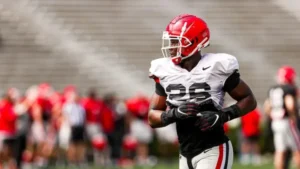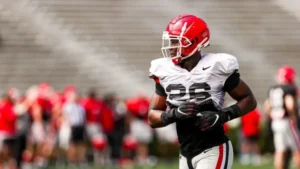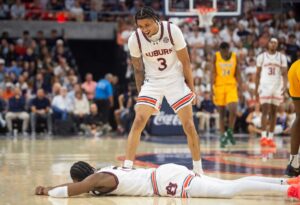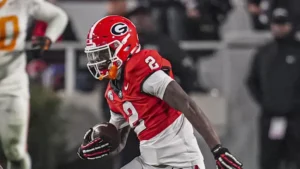
Gold Standard: How Notre Dame’s Tight End Legacy Keeps the NFL Draft Pipeline Flowing
The tight end tradition at Notre Dame is more than just a source of pride—it’s an institutional legacy that continues to produce NFL-caliber talent year after year. With another former Irish tight end projected to hear his name called in the 2025 NFL Draft, Notre Dame extends a remarkable streak that affirms its position as one of the premier tight end factories in college football history.
This legacy isn’t just about individual success—though there’s plenty of that—it’s about a system, a culture, and a tradition that has stood the test of time.
A Lineage of Greatness
Notre Dame’s reputation for developing elite tight ends dates back decades. It’s a lineage marked by players like Dave Casper, a Pro Football Hall of Famer who helped lay the foundation in the 1970s. Since then, the Irish have churned out a steady stream of NFL-ready talent, with names like Mark Bavaro, Irv Smith Sr., John Carlson, Kyle Rudolph, Tyler Eifert, and Cole Kmet all making the leap from South Bend to the pros.
What makes this lineage especially remarkable is its consistency. Since 2001, 12 different Notre Dame tight ends have been drafted into the NFL. That includes a run of five consecutive drafts from 2019 through 2023 that featured at least one Irish tight end selected.
In 2024, the streak was technically broken—but only due to injury. Mitchell Evans, a top-tier talent expected to declare for the 2024 NFL Draft, was sidelined by a torn ACL. Now fully recovered and ready to showcase his skills at the next level, Evans is set to extend the Irish tight end legacy in the 2025 draft.
The Notre Dame Blueprint
So what sets Notre Dame apart when it comes to developing tight ends?
It begins with a clear identity. Notre Dame doesn’t just use tight ends—they feature them. From the Charlie Weis era through Brian Kelly and now under Marcus Freeman, the Irish offense has consistently treated the tight end position as a centerpiece rather than a supplementary role.
Whether it’s in-line blocking, route running, or seam-stretching athleticism, Notre Dame demands a complete skill set from its tight ends. That holistic approach prepares them for the multifaceted demands of the NFL.
“Our guys are asked to do everything,” said Irish tight ends coach Gerad Parker during a recent media session. “We don’t silo them into one job. We ask them to block defensive ends and run routes like wide receivers. That balance is what gets them ready for Sundays.”
Evans is the latest prototype of that philosophy. At 6-foot-5 and 260 pounds, he combines strength, hands, and athleticism, making him a matchup nightmare at the college level—and an intriguing option for NFL front offices.
The NFL Pipeline
Of course, talent and preparation are only part of the equation. Visibility matters too, and Notre Dame tight ends enjoy a platform that few programs can match.
Year after year, Notre Dame ranks near the top in nationally televised games, marquee matchups, and primetime slots. That exposure helps elevate the stock of draft-eligible players, including tight ends who might not generate the flashiest stats but demonstrate pro-ready traits on tape.
Cole Kmet, a second-round pick of the Chicago Bears in 2020, is a prime example. He caught just 43 passes in his final season at Notre Dame but entered the NFL with a reputation for being one of the most complete tight ends in the country. Now an anchor for the Bears’ offense, Kmet is part of a growing list of Irish alumni making an impact on Sundays.
Kyle Rudolph, who played 11 NFL seasons and made two Pro Bowls, once said, “Notre Dame made me a professional before I became one. Everything about the way we were trained prepared us for the next step.”
Development Through Adversity
The development path for Irish tight ends isn’t always linear. Injuries, scheme changes, and evolving team dynamics can all shape a player’s journey. But Notre Dame’s emphasis on mental toughness and adaptability means players are often more resilient when they reach the NFL.
Mitchell Evans is a case in point. Originally a quarterback in high school, Evans arrived in South Bend as a developmental project with raw tools and untapped potential. Under the guidance of Notre Dame’s coaching staff, he blossomed into a high-impact starter by his junior season.
Then came the setback—an ACL tear in October 2023 that threatened to derail his trajectory. But Evans attacked his rehab with the same discipline that made him a rising star. Now, as he prepares for the 2025 draft, NFL scouts are taking notice.
“He’s got everything you look for,” said one AFC scout during a recent evaluation. “If the medicals check out, he’s going to be a starter in this league for a long time.”
The Freeman Era and Continued Excellence
When Marcus Freeman took over as head coach in 2022, some questioned whether Notre Dame’s tight end tradition would maintain its prominence in a new system. But if anything, Freeman has doubled down on the position’s importance.
In fact, tight ends have remained critical to the Irish offense under offensive coordinator Mike Denbrock. Whether it’s in 12 personnel packages or flexing out to create mismatches, Notre Dame continues to showcase tight ends in ways that maximize their strengths.
The pipeline also remains strong on the recruiting trail. The Irish consistently land some of the top tight end prospects in the country, including recent blue-chip commits in the 2024 and 2025 cycles. With development-minded coaches and a proven track record of NFL success, it’s no wonder elite recruits view Notre Dame as the premier destination for tight ends.
Brotherhood Beyond South Bend
One of the unique features of Notre Dame’s tight end heritage is the brotherhood that exists between generations. Alumni regularly return to campus, offering mentorship and insight to the next wave of talent.
“There’s a real connection,” said Tyler Eifert, a former first-round pick who spent eight seasons in the NFL. “You feel like you’re part of a family that stretches beyond your own time at Notre Dame.”
That culture of continuity and support creates a reinforcing loop of excellence. Younger players not only learn from their coaches—they also benefit from a wealth of experience handed down by those who have walked the same path.
Eyes on the 2025 Draft
As the 2025 NFL Draft approaches, Mitchell Evans is poised to be the next name added to the illustrious roll call of Notre Dame tight ends in the pros. Though his college career was marked by both promise and adversity, Evans embodies the traits that have come to define the position in South Bend: toughness, versatility, and professionalism.
Scouts project him as a mid-round pick with upside to start early in his career, particularly in offenses that value physical tight ends who can operate in both the run and pass game. He’s drawn comparisons to recent standouts like Dalton Schultz and Hunter Henry, and interviews during the pre-draft process have reportedly gone well.
If Evans does indeed get selected in April, it will mark yet another chapter in Notre Dame’s tight end story—a narrative that has transcended eras, coaching changes, and offensive schemes.
A Tradition That Endures
In college football, few programs can claim a true position-specific legacy. Alabama’s running backs, LSU’s defensive backs, and USC’s quarterbacks come to mind. But when it comes to tight ends, Notre Dame stands alone at the top.
It’s not just a matter of sending players to the NFL—it’s about setting a standard for what the position can be. Notre Dame tight ends aren’t defined by stats or highlight-reel plays alone. They’re defined by reliability, versatility, and a deep understanding of what it takes to succeed at the next level.
For Mitchell Evans and those who follow, the message is clear: the road from Notre Dame to the NFL is still well-paved—and it runs straight through the tight end room.
As long as the Irish continue to invest in that legacy, the streak isn’t just alive. It’s thriving.





